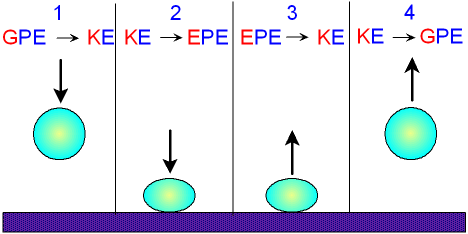
gcsescience.com 30 gcsescience.com
Gravitational Potential Energy to Kinetic Energy - Bouncing Ball.
What are the Energy Changes when a Ball Bounces?
1. A falling ball transfers GPE into KE.
2. When the ball hits the ground,
its shape changes and the KE is transferred into EPE.
3. As its shape is restored, the EPE changes back into KE.
4. As the bouncing
ball gets higher in the air,
KE is
transferred back into GPE.

When the ball bounces back up
into the air,
it does not go up to the same height at which
it started.
With each of the above transfers of energy,
some of the energy is wasted as heat.
In stage
1 energy is lost because of air resistance.
When the ball collides with the air
molecules,
both the ball and the air are made a little
warmer.
In stage 2
energy is lost when the
ball changes its shape
and the ball becomes warmer. Those of you
who play squash will be
familiar with this.
Stage 2 also
loses energy as sound when the ball hits the
ground.
Stage 3 loses energy for the same reason as stage 2.
Stage 4 loses energy for the same reason as stage 1.
If the energy transfers were
perfect and there were
no energy
losses,
the bouncing ball would always return
to the same height at which it started. It would carry on
bouncing like this forever. This would be called
"perpetual
motion".
Perpetual motion does not exist
because there are always energy losses during transfers.
![]() Links
Energy
Transfer
Revision Questions
Links
Energy
Transfer
Revision Questions
![]()
gcsescience.com Physics Quiz Index Energy Quiz gcsescience.com
Home GCSE Chemistry GCSE Physics
Copyright © 2015 gcsescience.com. All Rights Reserved.